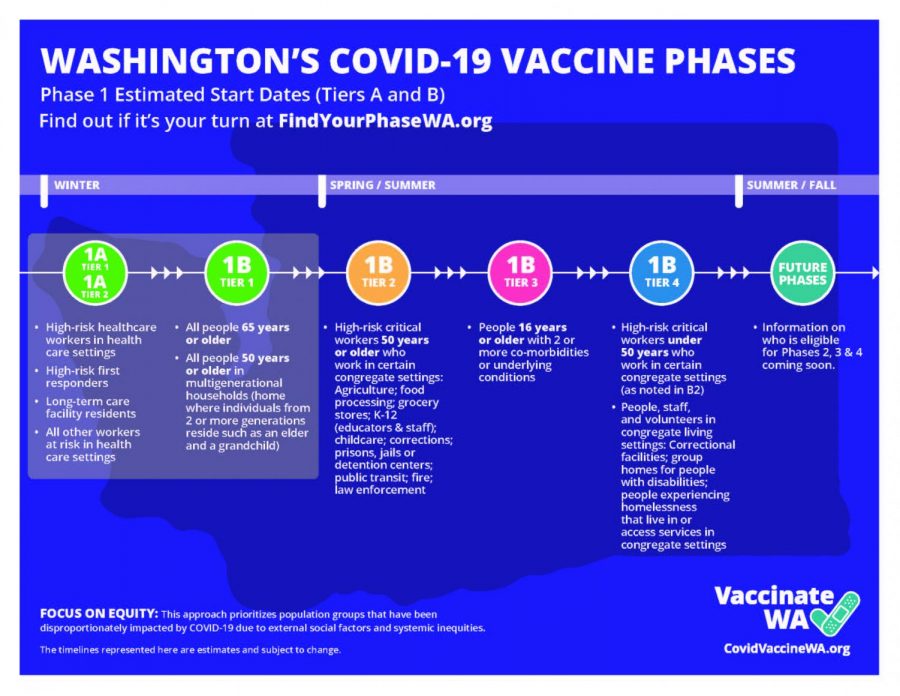Washington State Department of Health gives insight to the process of vaccine distribution in the state
February 23, 2021
Questions, concerns and explanations regarding Washington’s vaccine rollout were answered in a panel hosted by the Washington State Department of Health (DOH) on Feb. 18.
The DOH’s Secretary of Health Dr. Umair A. Shah discussed why the vaccination timeline can be lengthy. While there are phases in place, the amount of supply given to Washington cannot keep up with what the DOH hopes to administer. With the limited supply in mind, the DOH agreed to make these phases.
“If we had enough vaccines to go to everybody, we would simply snap our fingers and vaccinate the whole state of Washington,” Shah said.
Washington State Health Care Authority worker Dr. Christopher Chen said the vaccine should not cost any residents any money. Chen explained that providers who agreed to administer the vaccine agreed to not charge patients, and they cannot refuse anybody who does not have insurance. While patients do not have to pay, providers may still collect insurance information to receive funding to administer the vaccine.
If there are providers charging patients, Chen said, individuals can file complaints online at the Office of the Insurance Commissioner website.
All panelists agree that equity has been a great concern regarding the distribution of vaccine doses. Shah said to support the efforts, there have been mass vaccination sites for rural communities, and they are working with local partners to gain communities’ trust. Shah said he understands there are communities who have reasons why they do not trust them, and that local health departments can provide essential insight to their communities and hopefully gain trust.
“Local health departments are so important, tribal partners, everyone is so important,” Shah said.
The DOH’s COVID-19 Vaccine Director SheAnne Allen said the DOH is utilizing the social vulnerability index tool. This tool helps locate where vaccines should be distributed and helps figure out ways to deliver the vaccine, such as by working with hospitals, pharmacies, workplace clinics and setting mass vaccination sites. There are also appointments reserved for those who call in rather than placing an appointment online to include those who may not have internet access.
Recently, the CDC made an announcement regarding schools returning to in-person learning. The information discussed included efforts to safely conduct in-person learning, including topics such as altering classrooms, enforcing masks and providing alternative virtual options for students and teachers who are classified as at-risk.
Regarding the state’s stance on teachers being vaccinated, Shah said, “We know that education is so important, and we absolutely value our teachers … We want to make sure that we recognize that.”
While Shah said teachers are very important, they do not want to sacrifice vaccine doses that can be given to those 65 years of age and above.
Allen said over 20 Washington tribes have decided to receive vaccinations through the state, and around 10 have chosen to go through Indian Health Services (IHS).
As the tribes receive vaccine doses, they can choose what phases they want to go through when it comes to administering vaccinations to their tribal members. Allen gave the example of potentially choosing to vaccinate elders before healthcare workers. The state guidelines are not mandatory for tribes to follow.
With the current rollout of vaccinations, there have been some notable successes made in that time. Allen said one million doses have been administered in nine weeks. Over 1,200 providers and facilities enrolled to administer the vaccine, however some cannot be allocated due to the limited supply of vaccine doses Washington is receiving.
Shah said as soon as late next week, Washington could be receiving the first shipment of a third vaccine made by Johnson & Johnson.
Chen said the public can prepare for vaccinations by being patient and continuing the current public health measures.


